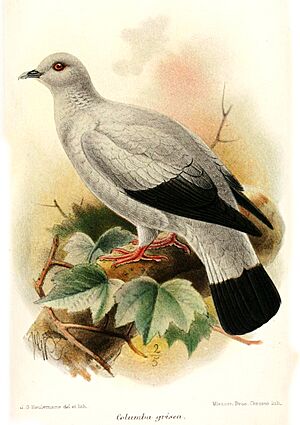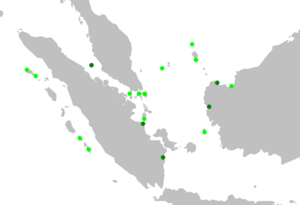Silvery pigeon facts for kids
Quick facts for kids Silvery pigeon |
|
|---|---|
 |
|
| Illustration by Keulemans, 1893 | |
| Conservation status | |
| Scientific classification | |
| Genus: |
Columba
|
| Species: |
argentina
|
 |
|
| Distribution of the silvery pigeon. Verified records are light, unconfirmed ones dark green. | |
| Synonyms | |
|
Carpophaga grisea Grey, 1844 (nomen nudum) |
|
The silvery pigeon (Columba argentina) is a type of pigeon found in Indonesia and Malaysia. It is also known as the silvery wood-pigeon or grey wood-pigeon. For a long time, people thought this bird was extinct. However, in 2008, wild groups were found near Masokut Island in the Mentawai archipelago. Photographs from Simeulue also proved that it still exists there.
Contents
What Does the Silvery Pigeon Look Like?
From far away, the silvery pigeon looks very much like the pied imperial pigeon. But if you look closely, you can spot some key differences. The silvery pigeon always has a pale, shiny silver-grey color. Its wing feathers and the tips of its tail feathers are black. Sometimes, you might see a slight green shine on the feathers at the back of its neck.
How to Tell it Apart from Other Pigeons
One easy way to tell the silvery pigeon apart is by its tail. The black part of its tail is the same length on all feathers. In the pied imperial pigeon, the black part forms a triangle shape on the underside of its tail.
The head also has special features. The silvery pigeon has a sloping forehead, unlike the rounded head of the pied imperial pigeon. It also has clear dark red or purplish skin around its eyes, which the pied imperial pigeon does not have. The silvery pigeon's beak is darker at the base and has a pale apple-green tip. Its feet are bluish-grey with some red spots.
Size and Weight
Silvery pigeons are a bit smaller than pied imperial pigeons. They are about 36 centimeters (about 14 inches) long. Female pigeons are usually a little bigger and darker than males. Young birds look a bit more sandy-colored on their upper feathers and chest. While their exact weight isn't known, experts guess they weigh around 350 grams (about 12 ounces).
The silvery pigeon's unique color pattern helps it blend in with the pied imperial pigeon. This is a type of convergent evolution, where different species develop similar traits. It might also be a case of Müllerian mimicry. This means the silvery pigeon might copy the pied imperial pigeon's behavior of gathering in large flocks. This makes it harder for predators to catch them, giving the rarer silvery pigeon a better chance to survive.
Where Do Silvery Pigeons Live?
In the late 1800s and early 1900s, silvery pigeons were seen on islands off the coast of Indonesia and west of Sumatra. They were also found on the nearby mainland. The first record of this bird was from near Pontianak before 1850.
Past and Present Locations
Over the years, there have been confirmed sightings in many places. These include Burong Island, Sarawak (1899), Saya in the Lingga Islands (1899), and Simeulue (1901). They were also seen in the Mentawai Islands, the Riau Islands, and the Anamba Islands.
After 1931, sightings became very rare. People thought the bird might be gone forever. But in 2008, a photograph confirmed that the species still lives in the wild. This photo was taken between Mastokut Island and Simaimu Islands, near Siberut in the Mentawai Islands.
In 2011, silvery pigeons were seen for the first time at Tanahbala in the Batu Islands. They were also seen with pied and green imperial pigeons. In 2016, a zoo in Nias found two silvery pigeons in their care during an inventory check.
What Do Silvery Pigeons Eat and How Do They Live?
Silvery pigeons live in mangrove forests and other woodlands on low-lying islands and coastal areas. They usually stay below 100 meters (about 330 feet) above sea level. It is believed that they travel around to find fruit that is in season. They are often seen with much larger groups of pied imperial pigeons.
Reproduction and Nesting
Silvery pigeons also nest in the same places as pied imperial pigeons. They likely breed over several months, starting around March or April. Like most other pigeons, they build a simple nest out of sticks in trees. The female lays a single white egg. This egg has a chalky shell, not a shiny one.
What is the Silvery Pigeon's Current Status?
The Silvery Pigeon is currently listed as Critically Endangered (D1) by BirdLife International. This means experts believe there are fewer than fifty adult birds left. However, this number is based on how few times the bird has been seen. It's possible there are more silvery pigeons, but they are just hard to identify because they look so much like the pied imperial pigeon.
Why Are They Endangered?
The reasons for the pigeon's decline are not fully known. Losing mangrove forests and other woodlands definitely harms these birds. However, this destruction wasn't widespread when the bird started disappearing. Also, new predators like wild cats can be a problem for birds nesting on small islands. But this wasn't a major issue when the sightings stopped.
Today, silvery pigeons are no longer found on Burong, the Mentawi, or the Riau Islands. They likely only live on Siberut, Simeulue, and some nearby small islands.
Recent Sightings and Hope
There were some reports in the 1980s and 1990s of many silvery pigeons in places like Padang-Sugihan Wildlife Reserve and Berbak National Park in Sumatra. Some people think the bird might still exist in large numbers in these areas. However, these reports have not been officially confirmed. The species was never thought to be very common, especially compared to the pied imperial pigeon.
More recently, in 2001, a silvery pigeon was thought to be seen on Pulau Talang Besar in the Talang Talang Islands. There was also an unconfirmed report in 2002. These sightings give hope that the silvery pigeon is still out there.


